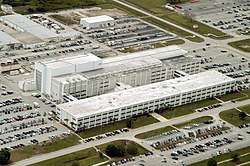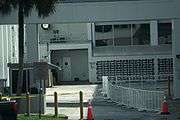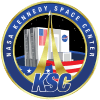Operations and Checkout Building
The Neil Armstrong Operations and Checkout Building (previously known as the Manned Spacecraft Operations Building) is a historic building on Merritt Island, Florida, United States. The five-story structure is in the Industrial Area of NASA's Kennedy Space Center. Its facilities include the crew quarter dormitories for astronauts, and suit-up preparations prior to their flights. The other facility is a large spacecraft workshop used for manufacturing and checking activities on crewed spacecraft. On January 21, 2000, it was added to the U.S. National Register of Historic Places.
Operations and Checkout Building | |
 Aerial view of the Operations and Checkout building at KSC, c. 2017 | |
  | |
| Location | Brevard County, Florida, USA |
|---|---|
| Nearest city | Titusville, Florida |
| Coordinates | 28°31′26″N 80°38′46″W |
| Built | 1964 |
| Architect | Charles Luckman |
| Architectural style | International |
| Visitation | Open, requires sponsorship by NASA employee |
| MPS | John F. Kennedy Space Center MPS |
| NRHP reference No. | 99001636[1] |
| Added to NRHP | January 21, 2000 |
Apollo program
When it was originally built in 1964 to process spacecraft in the Gemini and Apollo era, it was known as the Manned Spacecraft Operations Building. It was renamed the Operations and Checkout Building during the Shuttle program, known informally as the O&C.
Altitude test chambers

In 1965, a pair of altitude chambers were installed in the High Bay for testing the environmental and life support systems of both the Apollo Command/Service Module and Lunar Module at simulated altitudes of up to 250,000 feet (76 km). Each chamber is 58 feet (18 m) high (with a clear working height of 28 feet (8.5 m)) and an interior diameter of 33 feet (10 m),[2] were human-rated, and capable of reaching the maximum altitude (minimum pressure) in one hour. These were used by the prime and backup crews of all crewed missions, from the ill-fated Apollo 1 in October 1966, through to the Apollo-Soyuz Test Project in July 1975.[3]
Post-Apollo use
During the 1980s and 90s the O&C building was used to house and test Spacelab science modules before their flights aboard the Space Shuttle.
In the late 1990s and 2000s, some modules and trusses for the International Space Station were checked out in the building.
On January 30, 2007, NASA held a ceremony to mark the transition of the building's high bay for use by the Constellation program. The building would serve as the final assembly facility for the Orion crew exploration vehicle.[4] In preparation for the transition, the state of Florida provided funds to clear the facility of about 50 short tons (45 metric tons) of steel stands, structures and equipment.[5] Renovations totaling $55 million took place from June 2007 through January 2009,[6] at which point Lockheed Martin became the operator of the facility for Orion production.[7] The Orion spacecraft for Artemis 1 will complete its assembly in this location before being handed to launch operations.
The building was renamed to the Neil Armstrong Operations and Checkout Building in a ceremony on the 45th anniversary of Apollo 11 (2014).[8]
Gallery
 The O&C in 1984
The O&C in 1984 Exit door from Operations and Checkout Building connector. A nearby doorway on the adjacent north wall of the rear building is where Astronauts would board the Astrovan for transport to Launch Complex 39
Exit door from Operations and Checkout Building connector. A nearby doorway on the adjacent north wall of the rear building is where Astronauts would board the Astrovan for transport to Launch Complex 39 Apollo 11 crew members Neil Armstrong, Michael Collins, and Buzz Aldrin on the morning of July 16, 1969
Apollo 11 crew members Neil Armstrong, Michael Collins, and Buzz Aldrin on the morning of July 16, 1969 The spacecraft workshop number 1
The spacecraft workshop number 1 Orion Spacecraft in the workshop of the Operations and Checkout Building
Orion Spacecraft in the workshop of the Operations and Checkout Building Astronauts sleep prior to launch day in dormitories in the Operations and Checkout Building, in this case a bedroom is undergoing renovations
Astronauts sleep prior to launch day in dormitories in the Operations and Checkout Building, in this case a bedroom is undergoing renovations Astronauts have suit-up flight preparations in the building
Astronauts have suit-up flight preparations in the building
Notes
- "National Register Information System". National Register of Historic Places. National Park Service. July 9, 2010.
- Craig
- Slovinac, pp. 1-2
- Young
- Marconi, p. 2
- "Operations and Checkout Building High Bay Ready for Orion Processing". NASA. February 4, 2009. Retrieved 5 November 2015.
- "KENNEDY SPACE CENTER'S ANNUAL REPORT FY2008" (PDF). NASA's Kennedy Space Center. Retrieved 5 November 2015.
- Dean, James (July 22, 2014). "Neil Armstrong Legacy Adds Honor". Florida Today. Cocoa, Florida. p. A1 – via Newspapers.com.
References
- Craig, Kay (2011-06-14). "KSC Technical Capabilities: O&C Altitude Chambers". NASA.gov. Archived from the original on 2012-03-28. Retrieved 2011-07-29.
- Marconi, Elaine (2007-02-09). "NASA's next step to prepare for a new era of exploration" (PDF). Spaceport News. NASA. 46 (3). Retrieved 2009-08-06.
- Slovinac, Patricia (December 2009). "Cape Canaveral Air Force Station, Launch Complex 39, Altitude Chambers" (PDF). Historic American Engineering Record. Washington, D.C.: Library of Congress. Retrieved 2014-03-01.
- Young, Tracy (2007-01-24). "NASA Invites Media to Ceremony Marking Transition to Constellation". NASA.gov. Retrieved 2009-08-06.
External links
| Wikimedia Commons has media related to Operations and Checkout Building. |
- Operations and Checkout Building at NASA.gov
- Brevard County listings at the National Register of Historic Places
- KSC building reborn as 'Spacecraft Factory of the Future' Florida Today
- Historic American Engineering Record (HAER) No. FL-8-11-E, "Cape Canaveral Air Force Station, Launch Complex 39, Altitude Chambers, First Street, between Avenue D and Avenue E, Cape Canaveral, Brevard County, FL", 59 photos, 40 data pages, 7 photo caption pages

